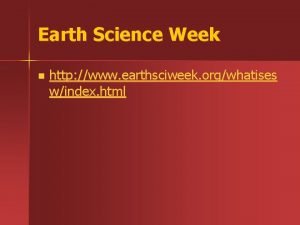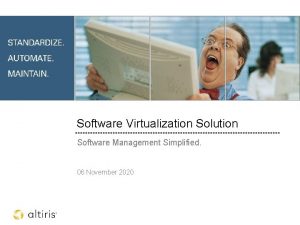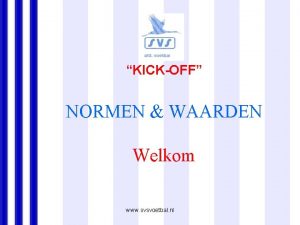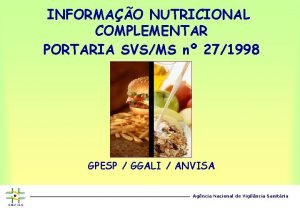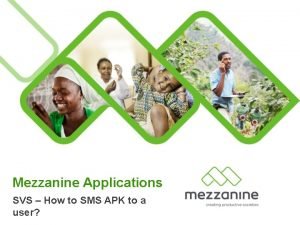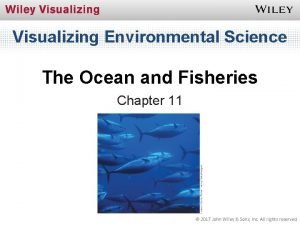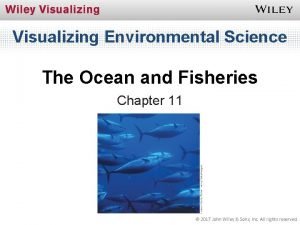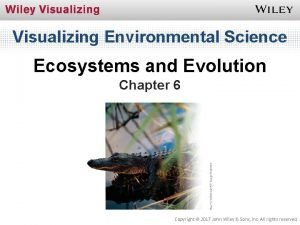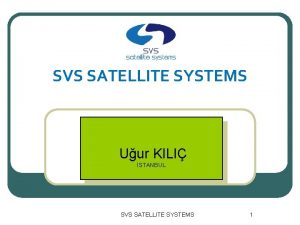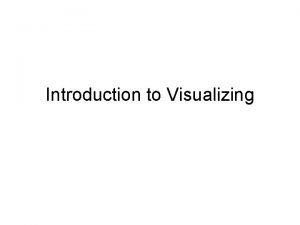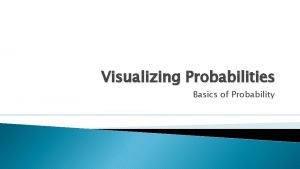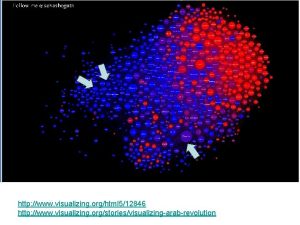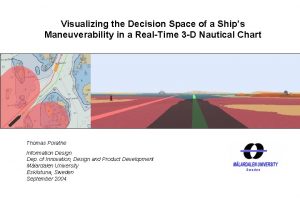Earth Science Week 2015 Visualizing Earth Systems svs









- Slides: 9

Earth Science Week 2015: Visualizing Earth Systems svs. gsfc. nasa. gov/ESW 2015 American Geosciences Institute (AGI) initiative; NASA has been a partner >12 years. NASA 2015 participation was implemented by cross-Center team (GSFC, JPL, La. RC) led by the Earth EPO Forum (IGES) 2015 ESW gallery hosted by NASA’s Scientific Visualization Studio. Curated visualizations, blog posts from scientists & engineers with reading guide, NASA Wavelength educational resources, and Inquiry. Teaching with NASA Visualizations by AGI/Center for Science & Society. >184, 000 hits (Oct. 1 -25). NASA DVD and Booklet (below) with distribution to 29, 700 educators through AGI ESW kits/networks/events, and NASA educator events and networks (e. g. , Mission EPO educator workshops, GLOBE, Museum Alliance, Solar System Ambassadors, NSTA conferences, etc. ) Social Media Campaign #ESW 2015 (Oct. 9 -25): Six shareables leveraged Earth Right Now campaign and NASA education networks for total reach >3 M, exposure >6 M (95% of traffic to #ESW 2015 result of NASA social media). Sample Twitter shareable text: Let visualizations take you where you will never be able to goinside a hurricane! #ESW 2015 http: //ow. ly/T 7 BPH NASA Center Events for Local Communities: • GSFC GPM weather workshop for preservice teachers • JPL Open House lenticular visualizing CA drought • La. RC Elementary GLOBE Read Out Loud of new Aerosols Storybook (throughout Oct. for ESW and Read Out Loud Week) Women@NASA featured female Earth scientists during October Left: La. RC Read Out Loud; Below: 3 rd graders interpreting NASA images (Credit: AGI) Theresa Schwerin, NASA Earth EPO Forum/IGES Oct 26, 2015

NASA Highlights from ESW 2015 • • Blog Posts by NASA Scientists, Engineers, and Educators “Evergreen” NASA Education Resources Inquiry-Based Teaching with Visualizations NASA Social Media Shareables for ESW 2015

Blog Posts by NASA Scientists, Engineers and Educators svs. gsfc. nasa. gov/ESW 2015 A reading strategies guide for using these first-hand stories in the classroom was developed by NASA EPO Forum/IGES to extend their use beyond ESW. It is posted with the blogs on the SVS ESW Gallery and as a blog post on NASA Wavelength.

Evergreen NASA Education Resources Several “evergreen” educational resources with shelf lives beyond ESW were developed or leveraged, including the following resources on the NASA ESW DVD and SVS Gallery. Top: A video introduction (5: 18) to NASA visualizations was produced by the GSFC Media Studio for the ESW DVD, featuring Kel Elkins giving insights into the creation of three visualizations included on the NASA ESW DVD. He also answered questions about his work, education and career. Middle: A NASA Live Shots video interview (11: 40) created by the GSFC Media Studio with GPM scientists answering questions by elementary-high school students of GPM Master and Pilot Teachers related to the IMERG global precipitation dataset and visualization showing six months of global precipitation. Bottom Left: Inquiry-Based Teaching with Visualizations paper created for ESW 2015 by Ed Robeck, AGI/Center for Science & Society, uses unlabeled versions of visualizations to facilitate beginning student interpretation. Bottom Middle: NASA ESW DVD/Booklet – Quick Start Guide for Educators – Includes a curated set of NASA visualizations, organized by crosscutting topics commonly found in K 12 curriculum: Cause and Effect; Systems and System Models; Energy and Matter; Stability and Change; Patterns, Similarities and Differences; Scale, Proportion and Quantity. The DVD and booklet was created by IGES working with NASA SVS and AGI.

Evergreen NASA Education Resources Top: The GLOBE Implementation Office contributed a NASA activity for the ESW 2015 -2016 calendar Below: Excerpt from the Reading Guide for Visualizing Earth Systems Blogs developed for teachers to use with the NASA ESW blogs.

Inquiry-Based Teaching with Visualizations I just wanted to share with you my excitement about having spent most of my day today working with the scientific visualizations DVD with third graders. It was amazing how engaged they were, and how much they got out of the images. I’ve never done the sequence on the folio we did with children so young, so I wanted to see what would happen. They could interpret the images pretty well in many ways, and even when they were incorrect about the data being shown (and most people would be), the images evoked some very high level thinking. I worked with three different groups (of three ability levels) for just under an hour each and it went wonderfully in each case. Ed Robeck, AGI/Center for Science & Society The University of Nebraska at Omaha is requesting a mini grant from the NE Space Grant to design a course for teachers and writes: In this course, I plan to use: Visualizing Earth Systems: A NASA Quick Start Guide for Educators, which provides a unique perspective of the interconnectedness of Earth's systems. They are designed to encourage student questioning and conversation - the first steps to inquiry-based learning. The in-service graduate students will be grouped according to grade levels and will use the Visualizing Earth Systems: K-12 Lessons which are a collection of reviewed standards-based resources for Earth and space science education. Carol Engelmann, Hubbard STEM Learning Instructor University of Nebraska at Omaha Photos from Ed Robeck’s visit to third grade classes NASA DVD of visualizations, which includes a curated set of visualizations for education, “Inquiry-Based Teaching with Visualizations” by Robeck – an introductory approach for facilitating student interpretation of NASA visualizations, and collection of K-12 lessons from NASA Wavelength.

NASA Social Media Shareables for ESW 2015 Six social media shareables were created to to promote NASA’s contribution to ESW. These leveraged the Earth Right Now campaign and tagline, “We Have a Different Way of Looking at Things” and were shared broadly through NASA and partner social media and education networks. Top: Dust in the Wind by Kel Elkins, GSFC Ever been wowed by a NASA science visualization? Learn how they're made in this blog #ESW 2015 ow. ly/T 1 LZz Bottom: Does what Happens in the Arctic, Stay in the Arctic? by Patrick Taylor, La. RC Arctic ice is reaching record lows; what does that mean for Earth's energy budget? #ESW 2015 ow. ly/T 7 SMR *Facebook messages also included the extended text: This blog post is part of a series of first-hand stories from NASA scientists, visualizers and educators that were created for Earth Science Week 2015: Visualizing Earth Systems, an American Geosciences Institute initiative. Read all the blogs and find educational resources for all ages at: svs. gsfc. nasa. gov/ESW 2015/

NASA Social Media Shareables for ESW 2015 Notes from the Underground by JT Reager, JPL Notes from the underground: Interpreting the data deluge to understand drought. #ESW 2015 http: //ow. ly/T 7 Dj. P Visualizations: A NASA Eye View of Our Earth by Dalia Kirschbaum, GSFC Let visualizations take you where you will never be able to go-inside a hurricane! #ESW 2015 http: //ow. ly/T 7 BPH

NASA Social Media Shareables for ESW 2015 Making Video Games for NASA by Kevin Hussey, JPL Not just for fun: learn how scientists make and use video games #ESW 2015 http: //ow. ly/Teh. Gj Chesapeake Bay Watershed in 661 Million Pixels, by Mike Taylor, GSFC The largest estuary in the U. S. gets a new portrait in 661 Million Pixels! #ESW 2015 http: //ow. ly/Toq 3 Y
 Earth science week
Earth science week Software virtualization solution
Software virtualization solution Svsvoetbal
Svsvoetbal Portaria svs/ms 27/1998
Portaria svs/ms 27/1998 Svs prüfungen
Svs prüfungen Mezzanine helium
Mezzanine helium Visualizing environmental science solution manual
Visualizing environmental science solution manual Visualizing environmental science solution manual
Visualizing environmental science solution manual Visualizing environmental science (doc or html) file
Visualizing environmental science (doc or html) file Week by week plans for documenting children's development
Week by week plans for documenting children's development
